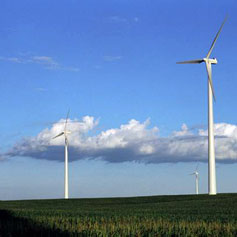Wind Energy
Most world wide power grids or distribution networks are saturated making it difficult or impossible to add additional generation capacity without significant modifications to the distribution networks. As the world's cities and industries grow so does the demand for more energy. There are many places in the world where huge wind farms could be built. Utilization of the power from these farms would require significant additions in infrastructure, backup generation capacity and power transmission lines. These costs often eliminate any benefits from economy of scale offered by the larger wind farms. However, if smaller wind turbines could be constructed with a similar economy on a smaller scale, then a small turbine could be economically installed on many business' roof tops. This would help feed local demand without direct impact to the large scale power grid. To make this concept practical with true economic and environmental benefit, two aspects need to be addressed. The first is a regulated restriction on limiting wind generation capacity within a particular region of the large scale power grid on a sector or area basis for the purpose of maintaining stability of the power grid and reducing the amount of backup generation required for that region. This requirement is dictated by the necessity to maintain grid stability and eliminate or reduce the need for equivalent backup capacity. Secondly the cost of small scale wind turbines needs to be significantly reduced to make it cost effective for small to medium applications.

KVA is working on technology in partnership with two other companies to reduce the cost by 40% of generating power and connecting that power to the grid. These savings combined with other unique simplifications in manufacturing and design result in overall cost reductions of 30-40% for wind turbines in the 2-20 kw range suitable for home or business use.
Capital and Installation Costs
The following table is provided for reference and comparison purposes. The table displays the cost in dollars per kilowatt of capacity. These numbers include the initial capital and installation costs to purchase and install an energy technology at a specified location. Capital costs refer to the total equipment cost of a power generation system (i.e., fuel cell system, combustion turbine, etc.) to the end user. This table also gives some comparison of the indirect costs associated with the technology. The last column is used to relate the cost of money and the relative return on investment. The lower the percentage the better. For instance solar is 69%, which when translated means that if all operating conditions of solar usage are optimal (365 days of sunlight), the savings provided from the generated electricity would just cover the interest expense.
| Capital Cost ($/kW) | Indirect Costs | Breakeven Usage* | |
|---|---|---|---|
| Nuclear | 2500-4000 | 1100-2500 (disposal) | 21% |
| Micorturbine | 700-1100 | 0 | 6% |
| Combustion Turbine | 300-1000 | 0 | 5% |
| IC Engine | 300-800 | 0 | 3% |
| Plasma Waste Conversion | 3000-5000 | 0 | 27% |
| Waste Heat to Electricity | 500-1800 | 0-1000 | 8% |
| Fuel Cell | 3,500-10,000 | 0 | 34% |
| Photovoltaic | 4,000-6,000 | 700-2100 | 69% |
| Wind Turbine | 800-3,500 | 300-1100 | 14% |
| *This represents the percentage of utilization required to simply offset the cost of money to install the system at 6% interest with a return based on $0.10 per kilowatt hour avoided electrical cost. | |||

